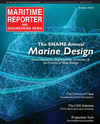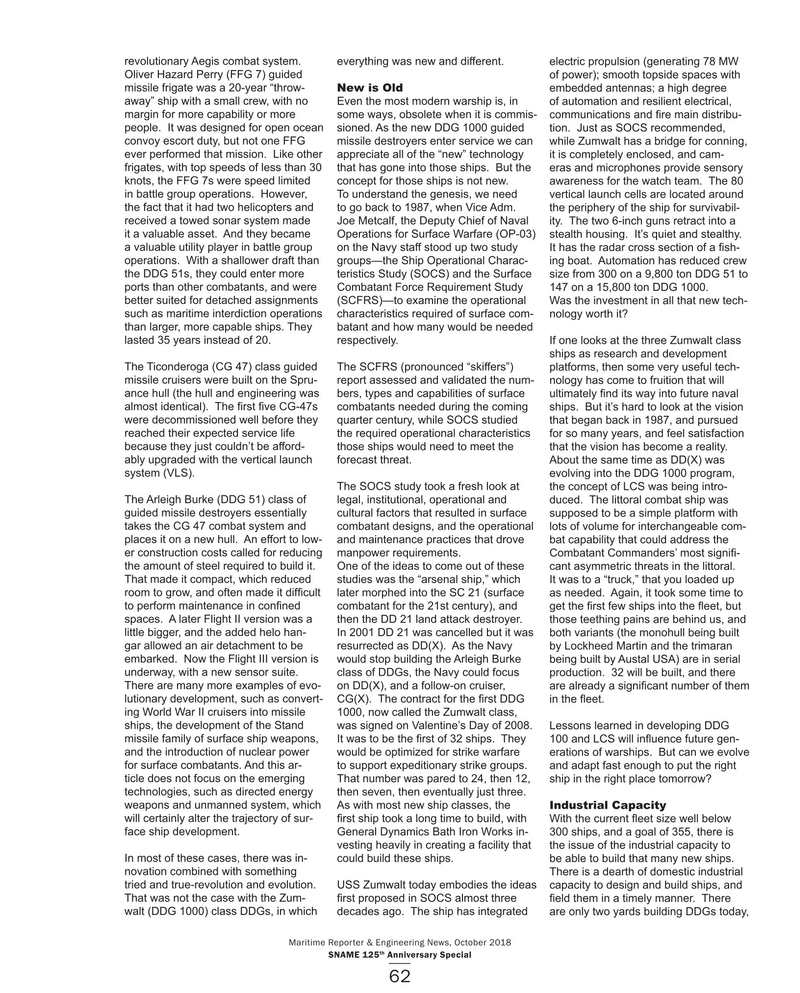
Page 62: of Maritime Reporter Magazine (October 2018)
Marine Design Annual
Read this page in Pdf, Flash or Html5 edition of October 2018 Maritime Reporter Magazine
revolutionary Aegis combat system. everything was new and different. electric propulsion (generating 78 MW
Oliver Hazard Perry (FFG 7) guided of power); smooth topside spaces with missile frigate was a 20-year “throw- New is Old embedded antennas; a high degree away” ship with a small crew, with no Even the most modern warship is, in of automation and resilient electrical, margin for more capability or more some ways, obsolete when it is commis- communications and ? re main distribu- people. It was designed for open ocean sioned. As the new DDG 1000 guided tion. Just as SOCS recommended, convoy escort duty, but not one FFG missile destroyers enter service we can while Zumwalt has a bridge for conning, ever performed that mission. Like other appreciate all of the “new” technology it is completely enclosed, and cam- frigates, with top speeds of less than 30 that has gone into those ships. But the eras and microphones provide sensory knots, the FFG 7s were speed limited concept for those ships is not new. awareness for the watch team. The 80 in battle group operations. However, To understand the genesis, we need vertical launch cells are located around the fact that it had two helicopters and to go back to 1987, when Vice Adm. the periphery of the ship for survivabil- received a towed sonar system made Joe Metcalf, the Deputy Chief of Naval ity. The two 6-inch guns retract into a it a valuable asset. And they became Operations for Surface Warfare (OP-03) stealth housing. It’s quiet and stealthy. a valuable utility player in battle group on the Navy staff stood up two study It has the radar cross section of a ? sh- operations. With a shallower draft than groups—the Ship Operational Charac- ing boat. Automation has reduced crew the DDG 51s, they could enter more teristics Study (SOCS) and the Surface size from 300 on a 9,800 ton DDG 51 to ports than other combatants, and were Combatant Force Requirement Study 147 on a 15,800 ton DDG 1000.
better suited for detached assignments (SCFRS)—to examine the operational Was the investment in all that new tech- such as maritime interdiction operations characteristics required of surface com- nology worth it? than larger, more capable ships. They batant and how many would be needed lasted 35 years instead of 20. respectively. If one looks at the three Zumwalt class ships as research and development
The Ticonderoga (CG 47) class guided The SCFRS (pronounced “skiffers”) platforms, then some very useful tech- missile cruisers were built on the Spru- report assessed and validated the num- nology has come to fruition that will ance hull (the hull and engineering was bers, types and capabilities of surface ultimately ? nd its way into future naval almost identical). The ? rst ? ve CG-47s combatants needed during the coming ships. But it’s hard to look at the vision were decommissioned well before they quarter century, while SOCS studied that began back in 1987, and pursued reached their expected service life the required operational characteristics for so many years, and feel satisfaction because they just couldn’t be afford- those ships would need to meet the that the vision has become a reality.
ably upgraded with the vertical launch forecast threat. About the same time as DD(X) was system (VLS). evolving into the DDG 1000 program,
The SOCS study took a fresh look at the concept of LCS was being intro-
The Arleigh Burke (DDG 51) class of legal, institutional, operational and duced. The littoral combat ship was guided missile destroyers essentially cultural factors that resulted in surface supposed to be a simple platform with takes the CG 47 combat system and combatant designs, and the operational lots of volume for interchangeable com- places it on a new hull. An effort to low- and maintenance practices that drove bat capability that could address the er construction costs called for reducing manpower requirements. Combatant Commanders’ most signi? - the amount of steel required to build it. One of the ideas to come out of these cant asymmetric threats in the littoral.
That made it compact, which reduced studies was the “arsenal ship,” which It was to a “truck,” that you loaded up room to grow, and often made it dif? cult later morphed into the SC 21 (surface as needed. Again, it took some time to to perform maintenance in con? ned combatant for the 21st century), and get the ? rst few ships into the ? eet, but spaces. A later Flight II version was a then the DD 21 land attack destroyer. those teething pains are behind us, and little bigger, and the added helo han- In 2001 DD 21 was cancelled but it was both variants (the monohull being built gar allowed an air detachment to be resurrected as DD(X). As the Navy by Lockheed Martin and the trimaran embarked. Now the Flight III version is would stop building the Arleigh Burke being built by Austal USA) are in serial underway, with a new sensor suite. class of DDGs, the Navy could focus production. 32 will be built, and there
There are many more examples of evo- on DD(X), and a follow-on cruiser, are already a signi? cant number of them lutionary development, such as convert- CG(X). The contract for the ? rst DDG in the ? eet. ing World War II cruisers into missile 1000, now called the Zumwalt class, ships, the development of the Stand was signed on Valentine’s Day of 2008. Lessons learned in developing DDG missile family of surface ship weapons, It was to be the ? rst of 32 ships. They 100 and LCS will in? uence future gen- and the introduction of nuclear power would be optimized for strike warfare erations of warships. But can we evolve for surface combatants. And this ar- to support expeditionary strike groups. and adapt fast enough to put the right ticle does not focus on the emerging That number was pared to 24, then 12, ship in the right place tomorrow?
technologies, such as directed energy then seven, then eventually just three. weapons and unmanned system, which As with most new ship classes, the Industrial Capacity will certainly alter the trajectory of sur- ? rst ship took a long time to build, with With the current ? eet size well below face ship development. General Dynamics Bath Iron Works in- 300 ships, and a goal of 355, there is vesting heavily in creating a facility that the issue of the industrial capacity to
In most of these cases, there was in- could build these ships. be able to build that many new ships. novation combined with something There is a dearth of domestic industrial tried and true-revolution and evolution. USS Zumwalt today embodies the ideas capacity to design and build ships, and
That was not the case with the Zum- ? rst proposed in SOCS almost three ? eld them in a timely manner. There walt (DDG 1000) class DDGs, in which decades ago. The ship has integrated are only two yards building DDGs today,
Maritime Reporter & Engineering News, October 2018 th
SNAME 125 Anniversary Special 62
MR #10 (58-65).indd 62 MR #10 (58-65).indd 62 10/5/2018 10:57:41 AM10/5/2018 10:57:41 AM

 61
61

 63
63
